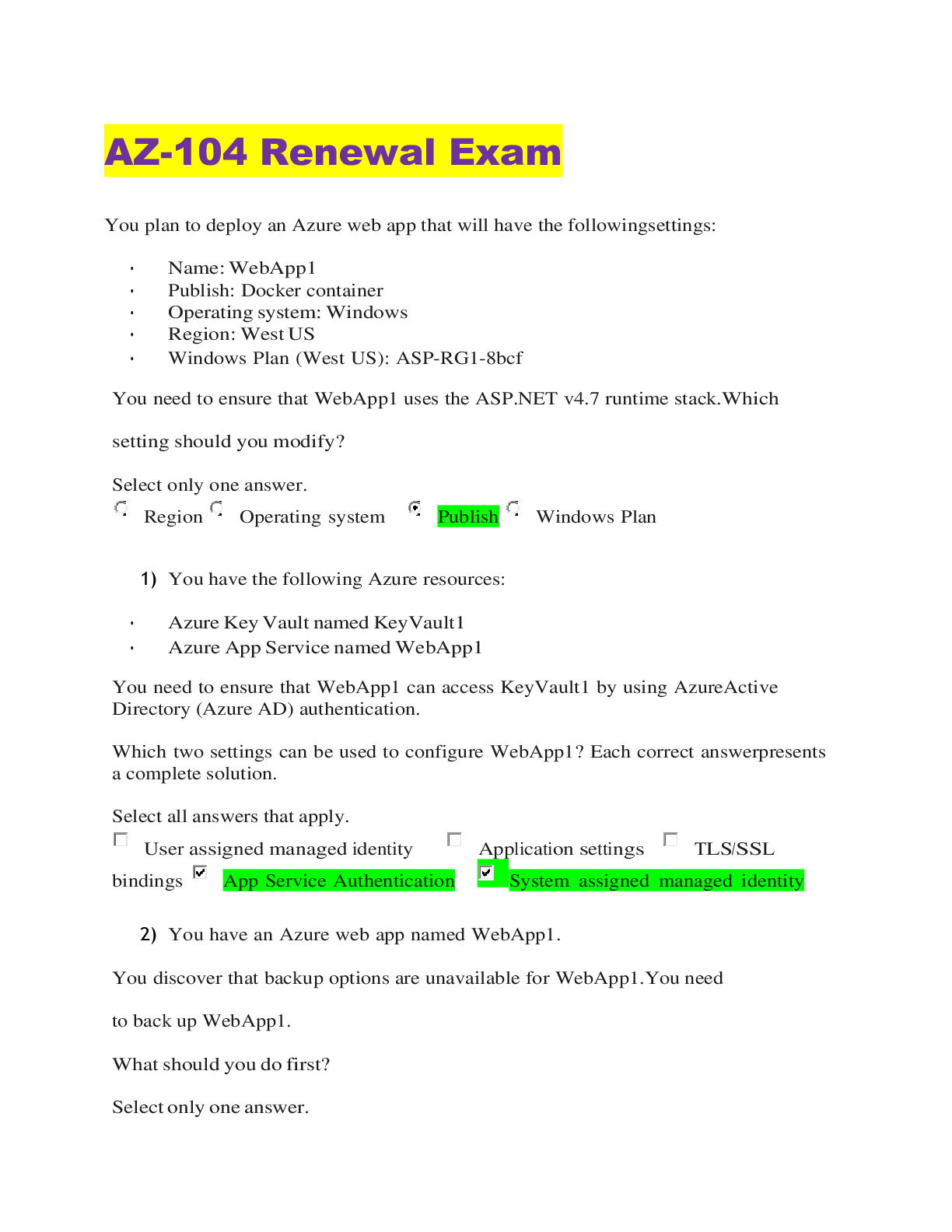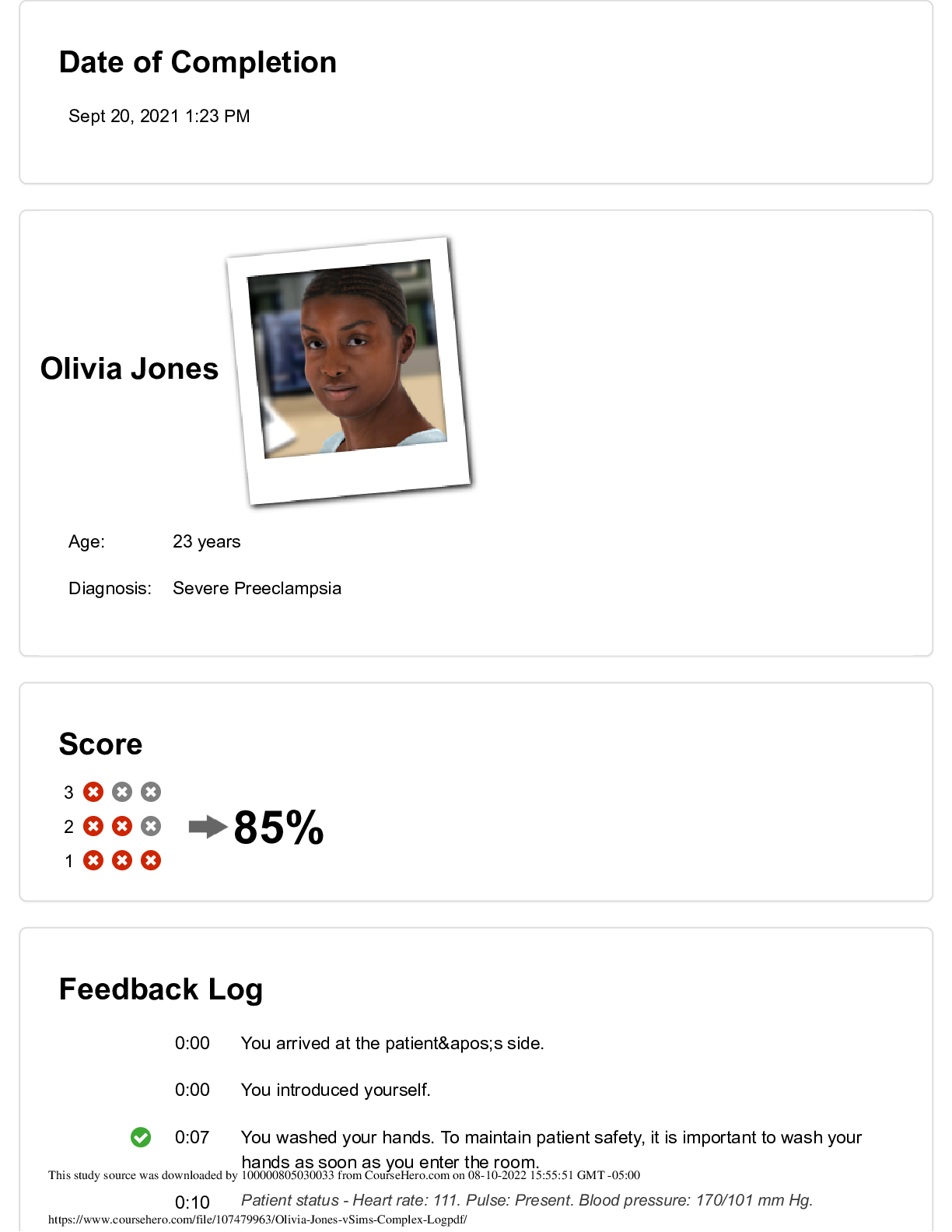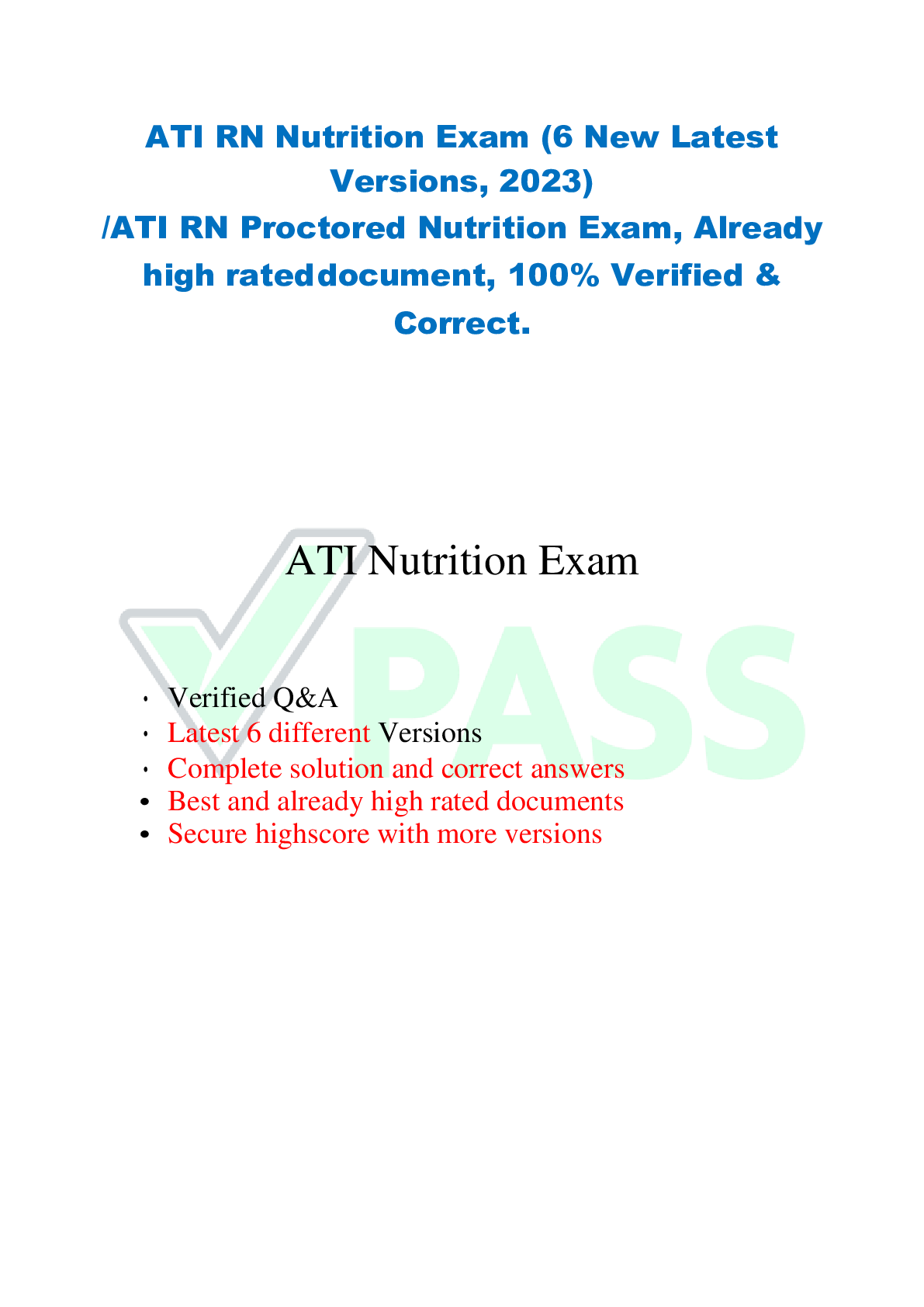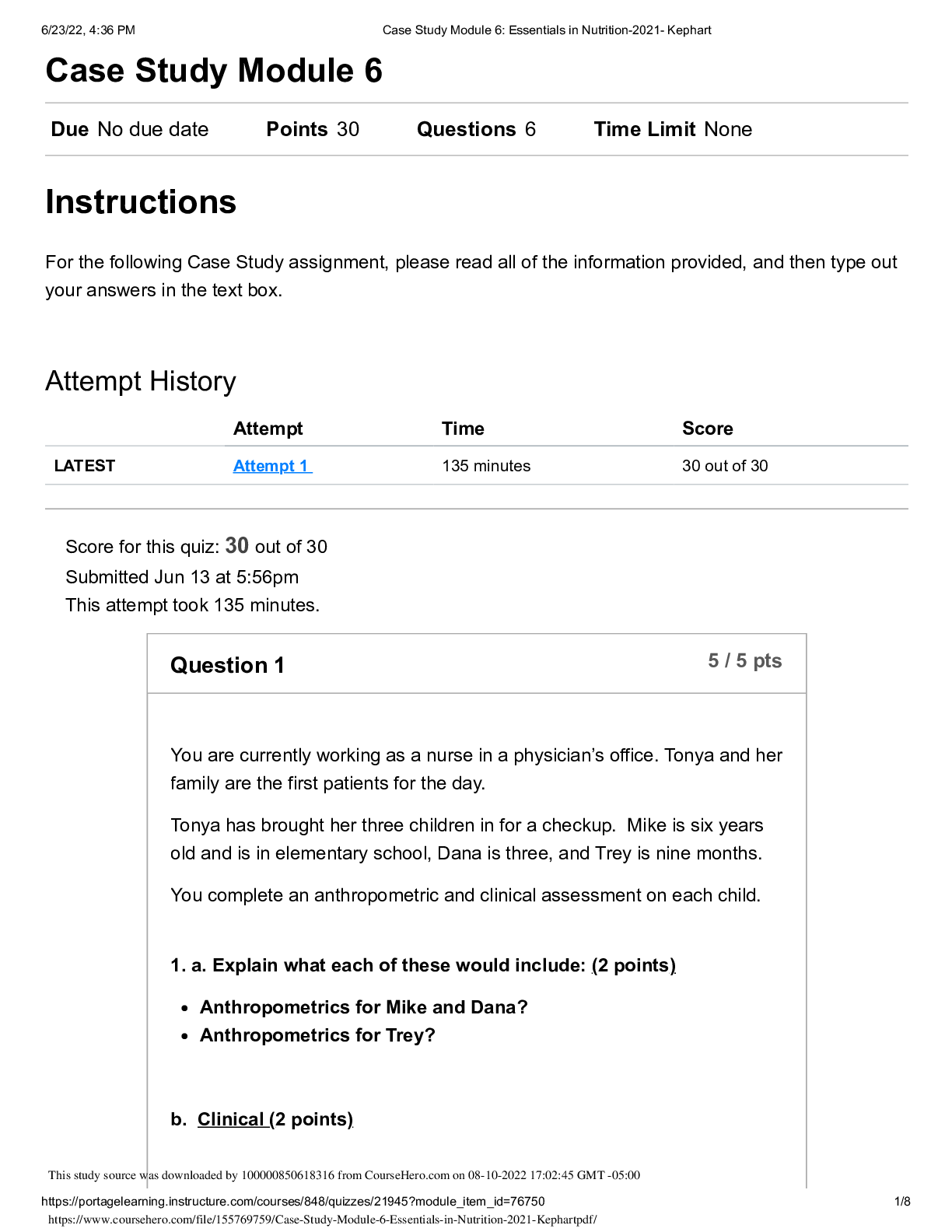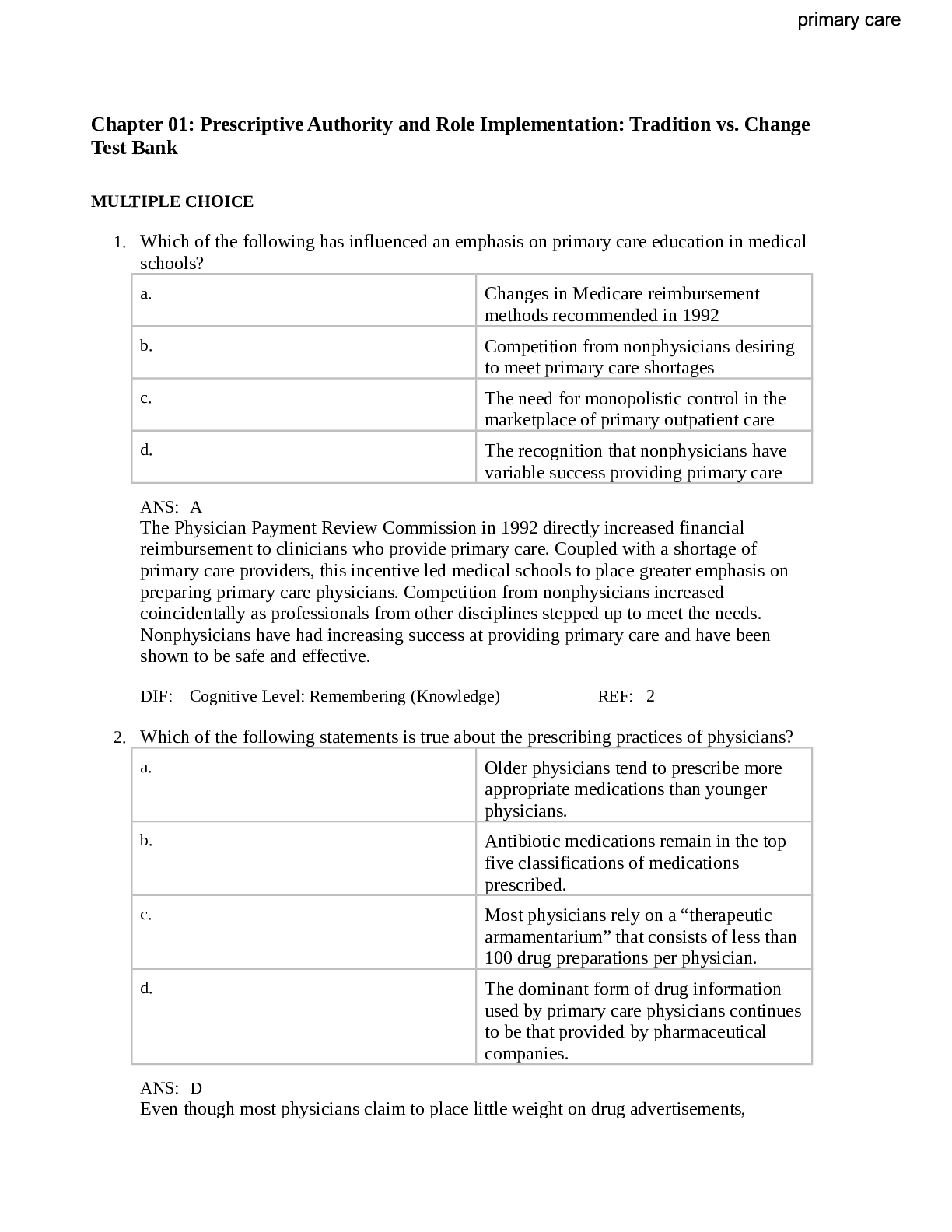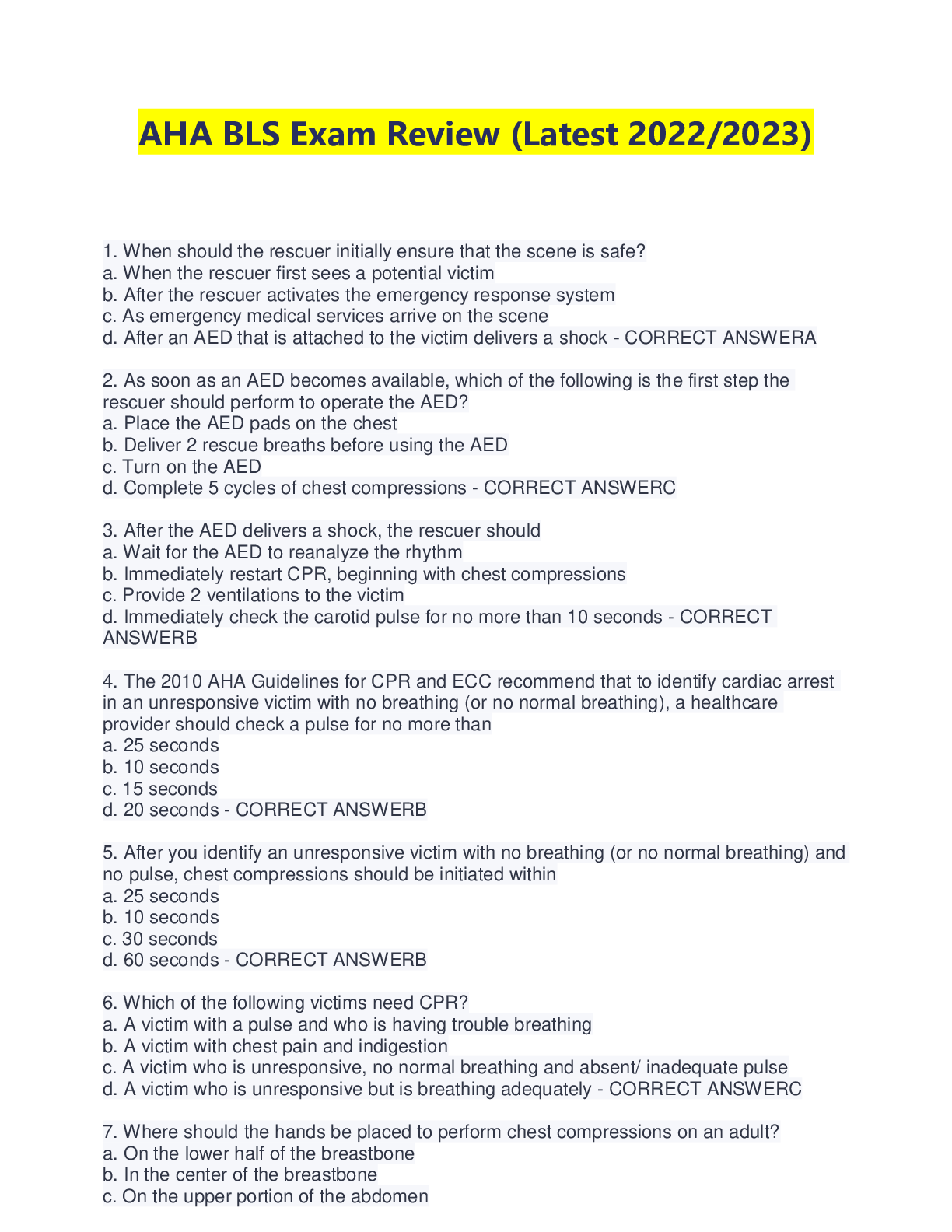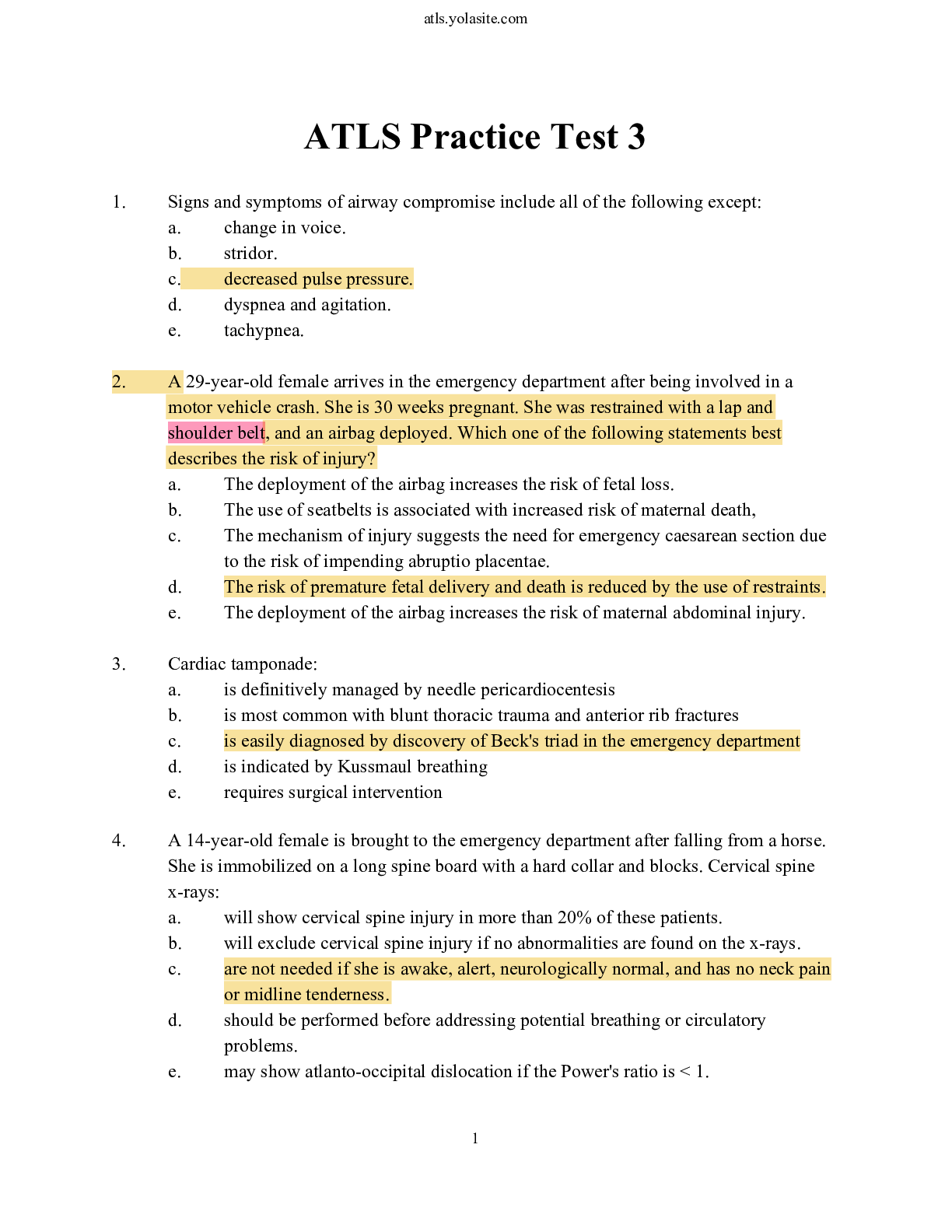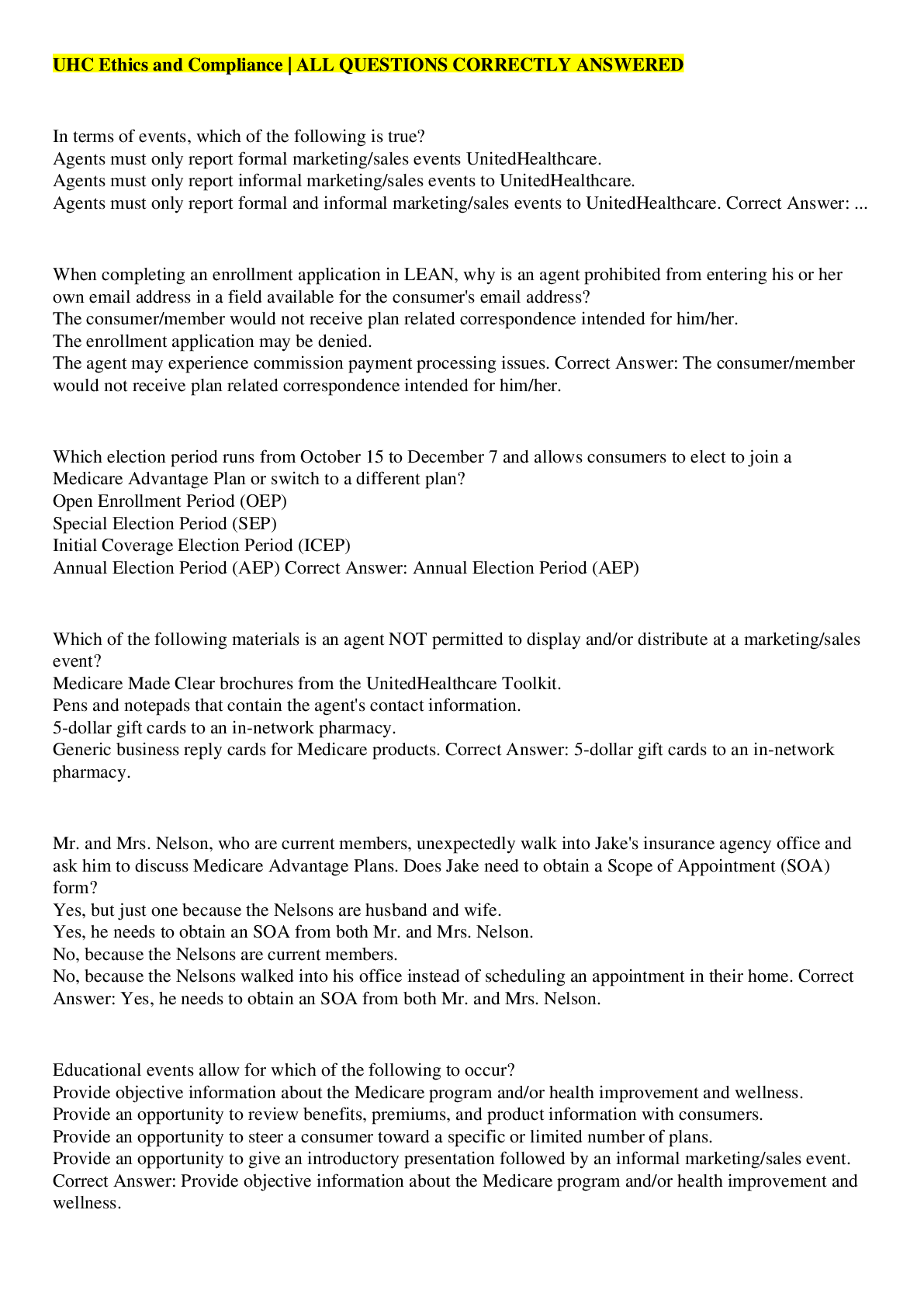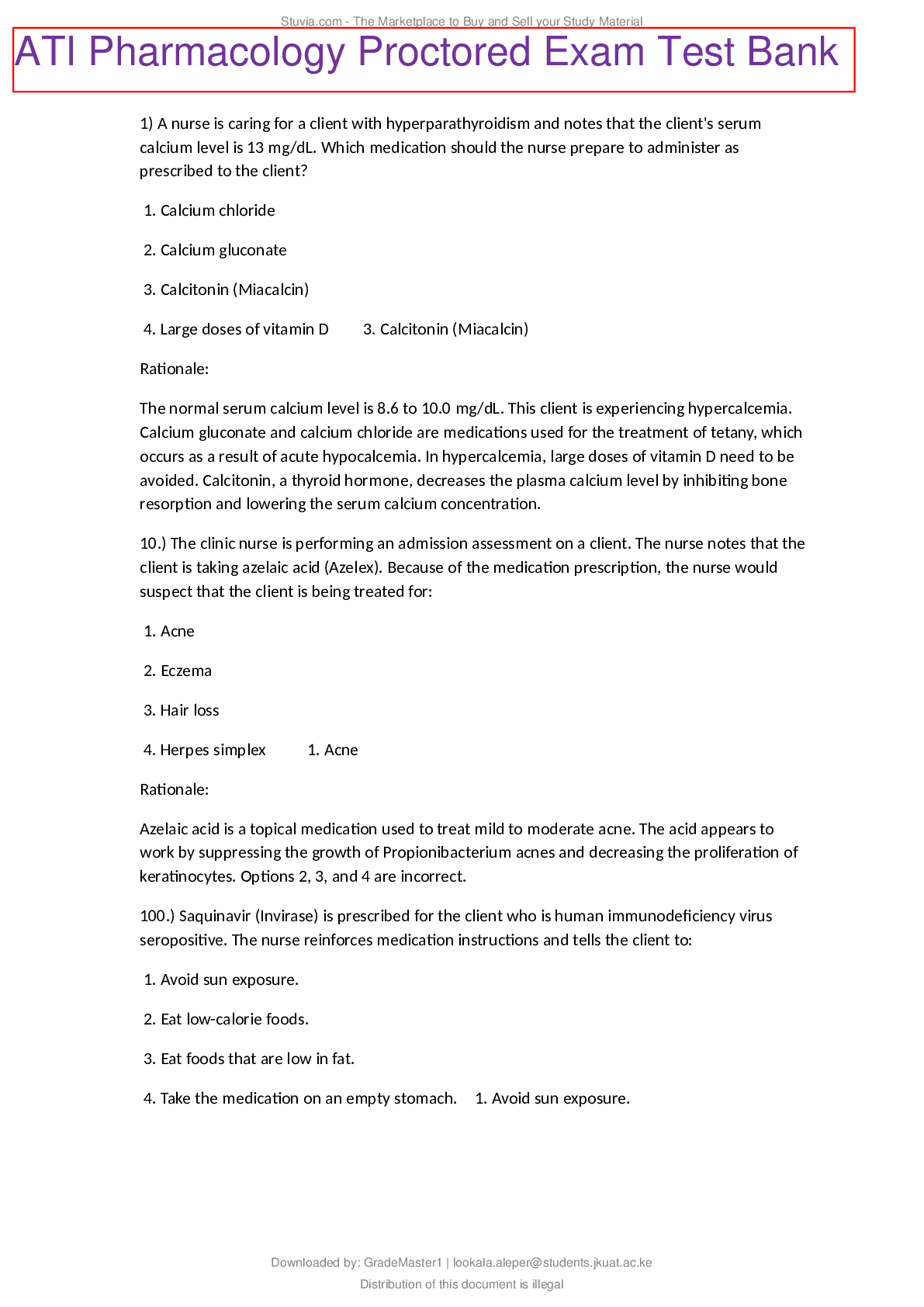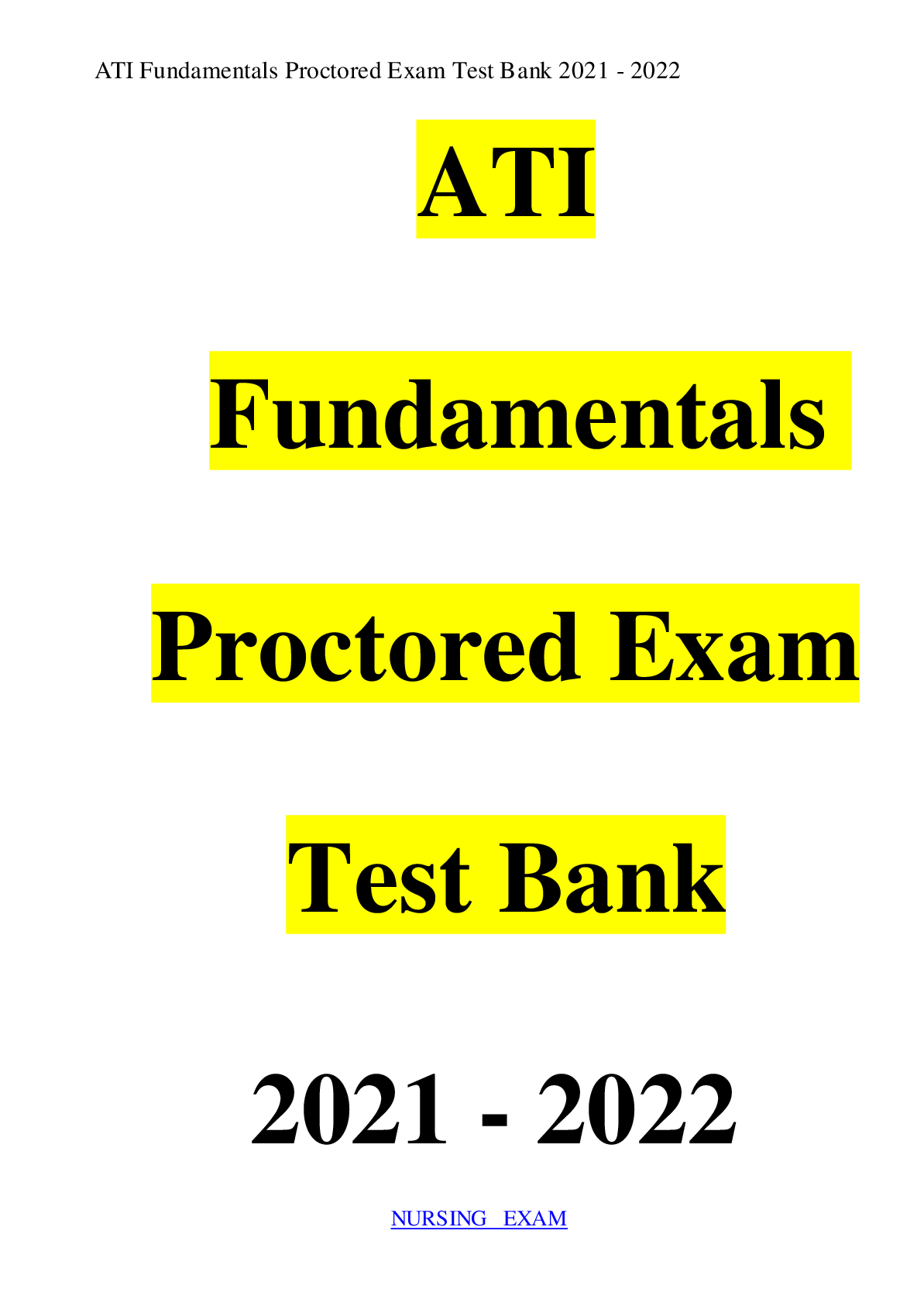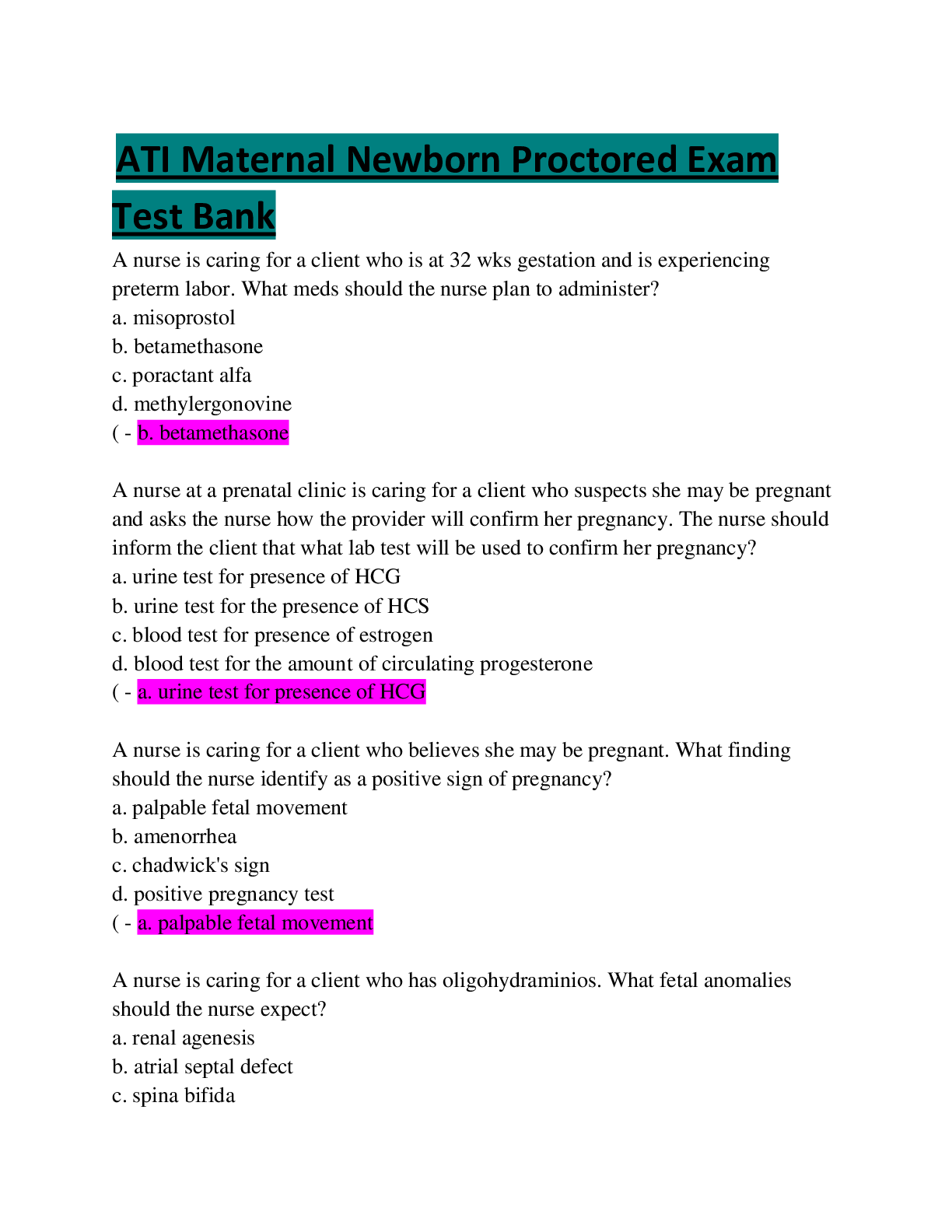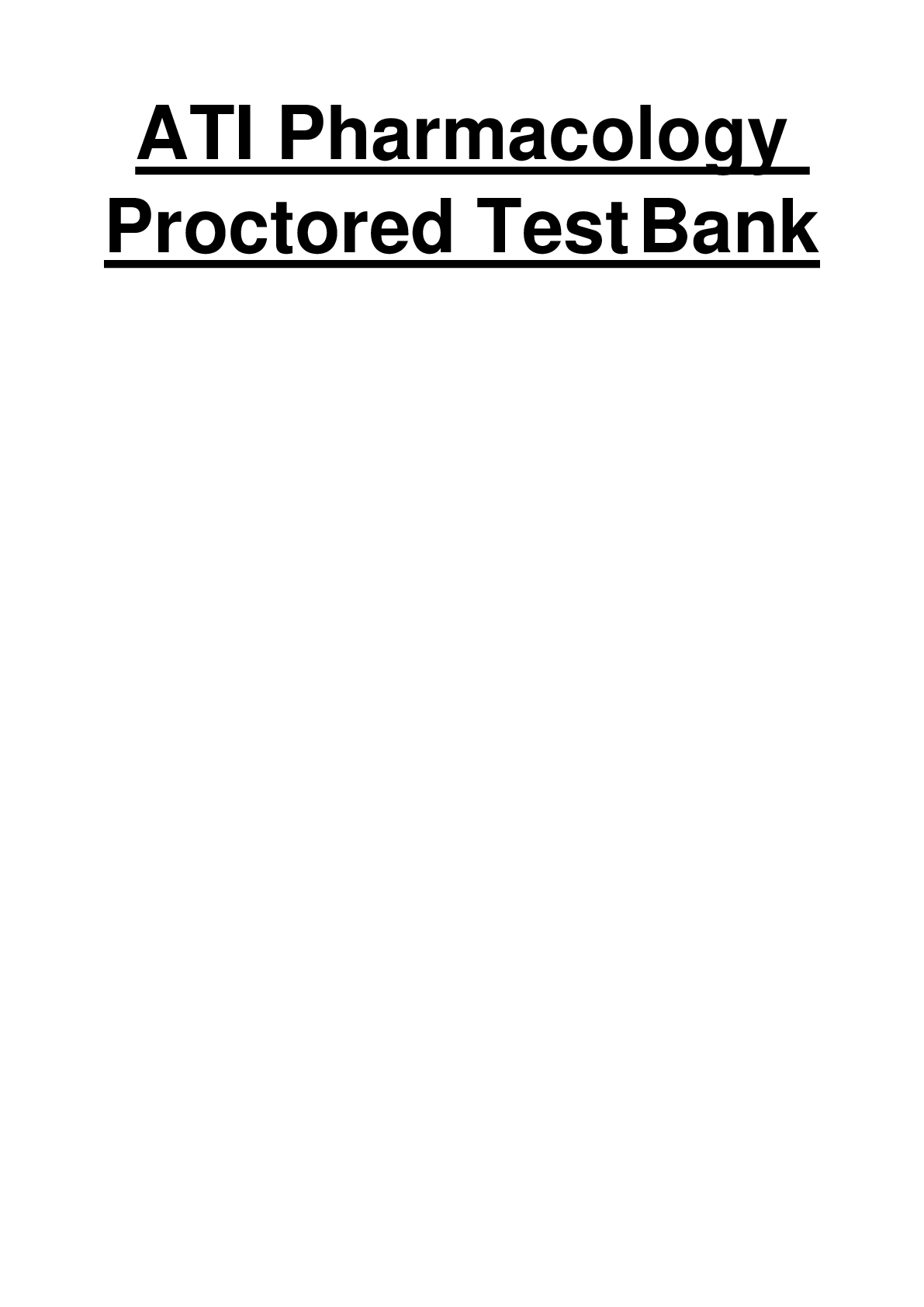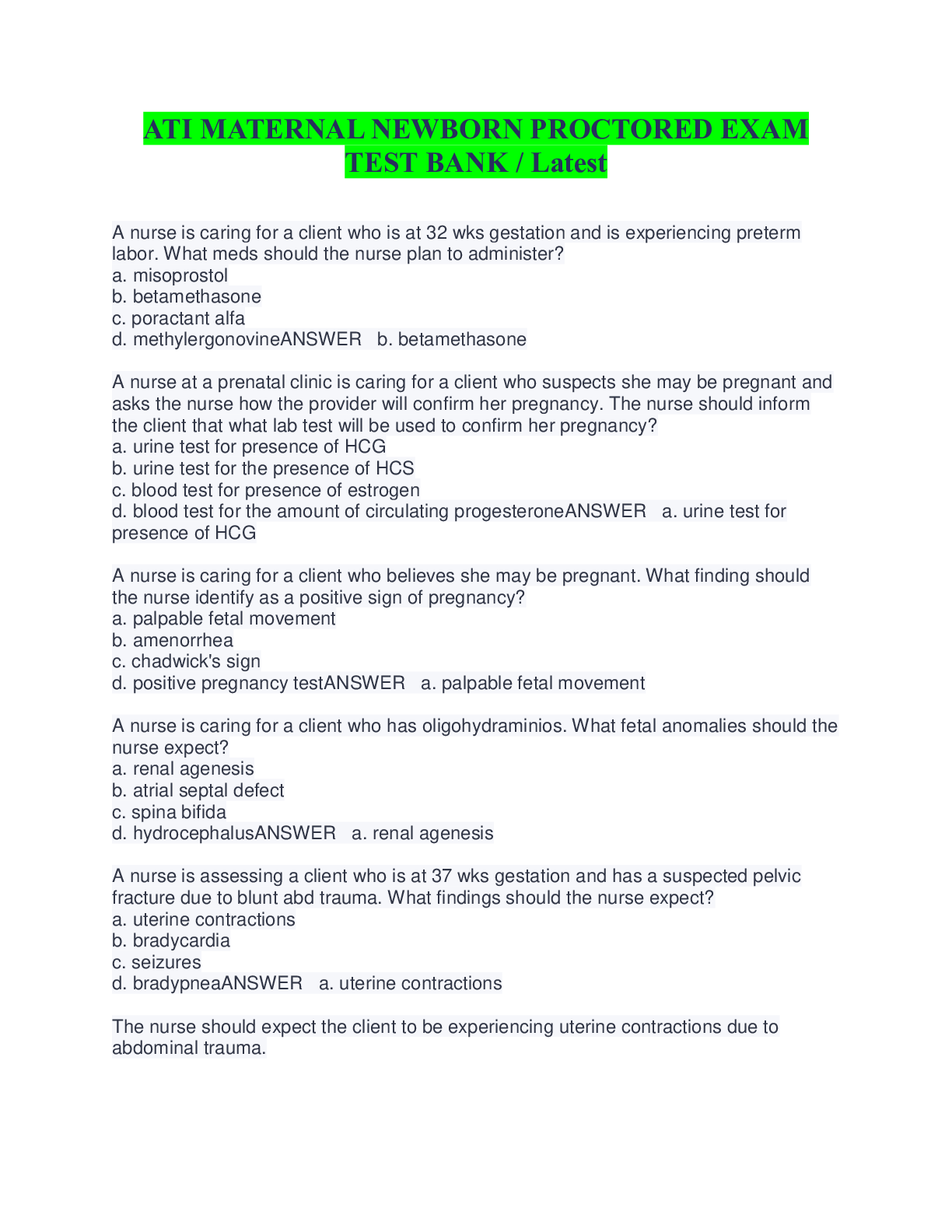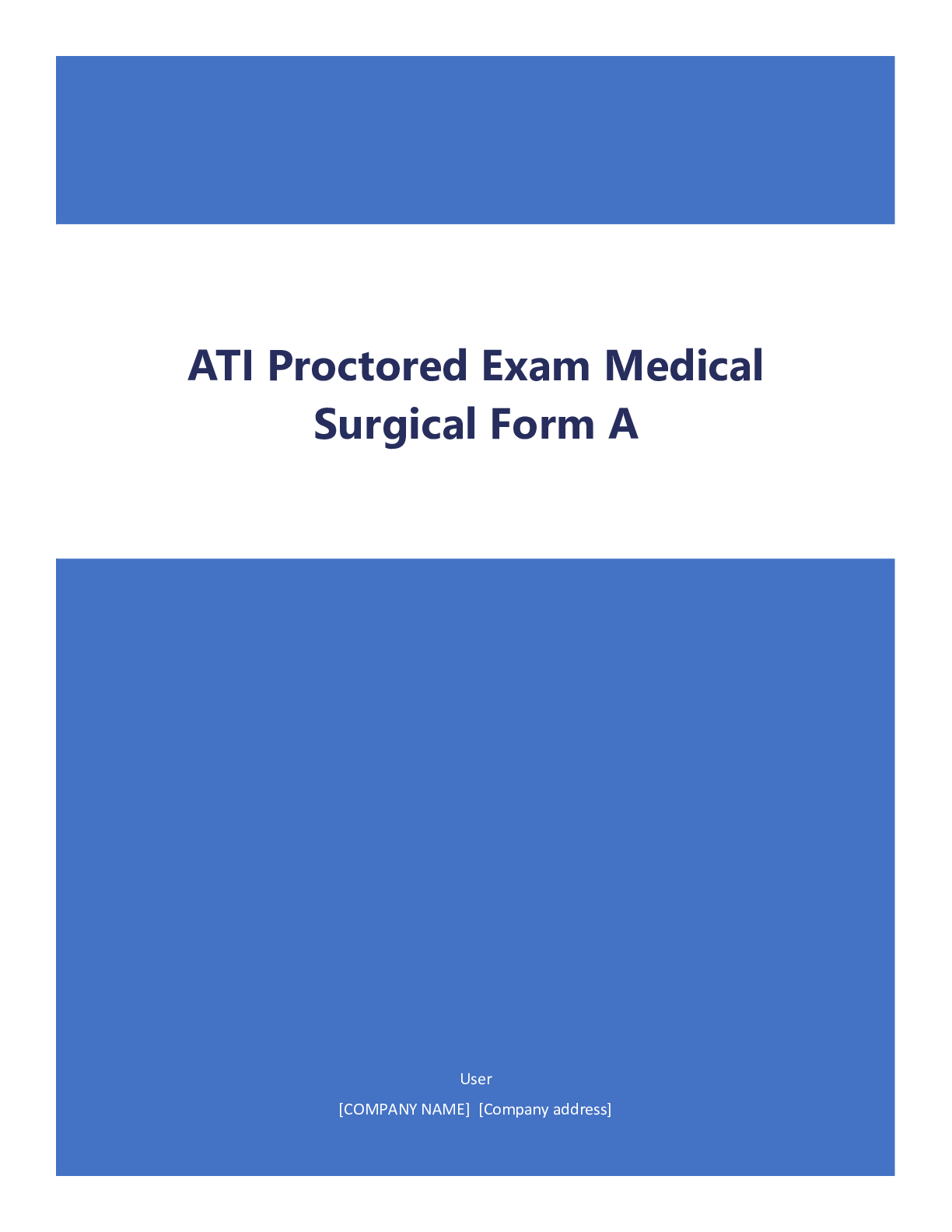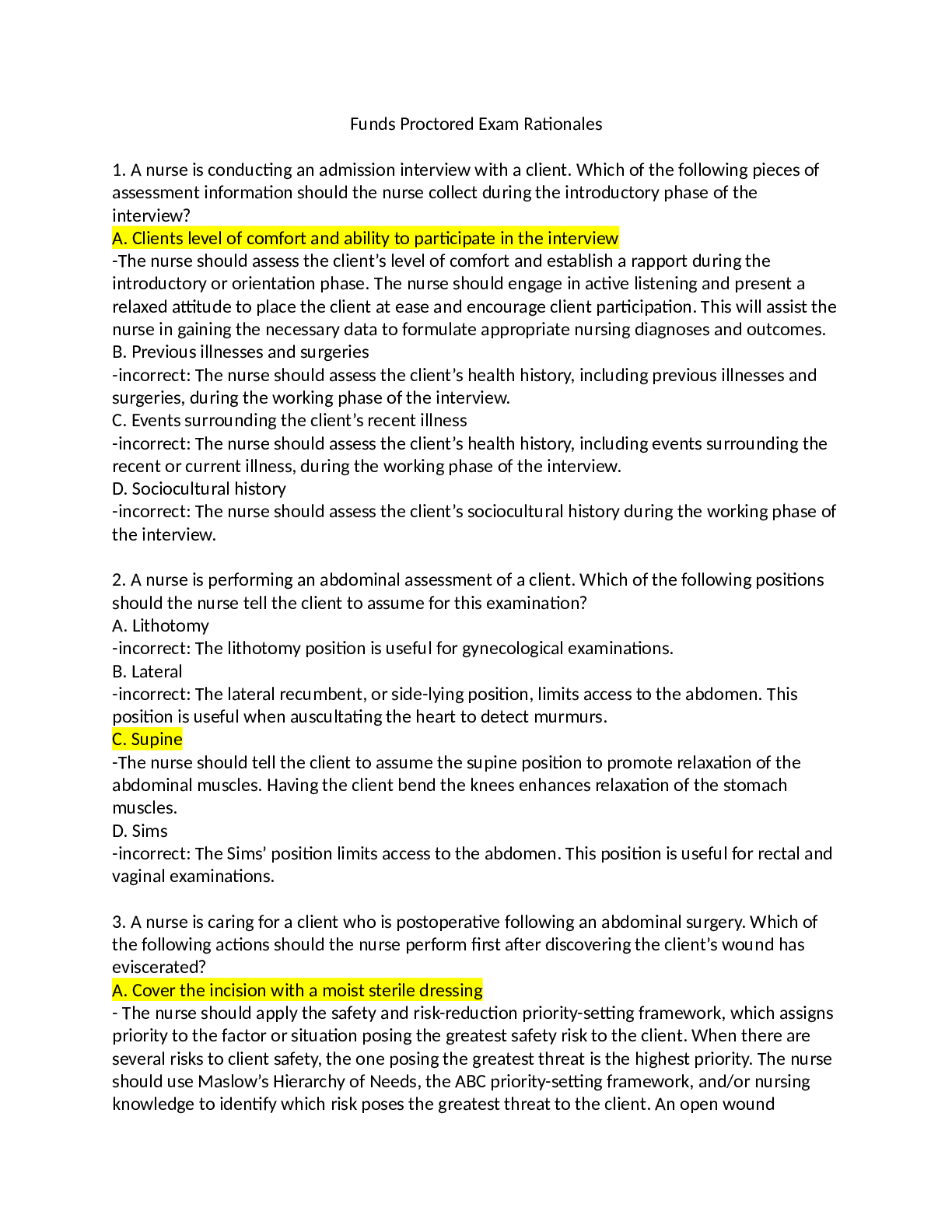ATI Fundamentals Proctored Exam Test Bank 2021 - 2022
Document Content and Description Below
ATI Fundamentals Proctored Exam Test Bank 2021 - 2022 1 A nurse is caring for a client who has left lower atelectasis. In which of the following positions should the nurse place ... the client for postural drainage? B. Right Lateral in Trendelenburg position 2 A nurse is caring for a client who is scheduled to have his alanine aminotransferase (ALT) levels checked. The client the nurse to explain the laboratory test. Which of the following is an appropriate response by the nurse?C. "This test will provide information about the function of your liver" 3 A nurse is caring for a client who has a perscription for morphine 5mg IM accidentally administers the whole 10 mg form the single-dose vial. Which of the following actions should the nurse take first? D. Measure the client's respiratory rate. Rationale : Morphine can cause respiratory depression if given too much. Also you should ALWAYS ASSESS the patient first when a med error is performed to make sure med error doesn‟t put the client‟s health in risk. 4. A nurse is preparing to administer diphenhydramine 20 mg orally to a 6-year-old child who has difficulty swallowing pills. Available is diphenhydramine 12.5 mg/5 mL oral syrup. Which of the following images shows the correct # of mL the nurse should administer? (Round the answer to the nearest whole number.) Click on the syringe that has 8 mL of med. 20 mg x (5mL/12.5mg) = 8 mL 5. A nurse is caring for a 6-year-old child who has a new prescription for cefoxitin 80 mg/kg/day administered intravenously every 6 hour. The child weighs 20 kg. How much cefoxitin should the nurse administer with each dose? (Round the answer to the nearest whole number. Use a leading zero if it applies. Do not use a trailing zero.) So it says each dose for the final answer, but we are given 80 mg/kg/day. 80 x 20 = 1600 / 4 (dose is given every 6 hours a day) =400 mg Rationale: 80 mg x 20 kg = 1,600 1,600/4 x day (q6h) = 400 mg 6. A nurse is preparing to administer IV fluids to a client. The nurse notes sparks when plugging in the IV pump. Which of the following actions should the nurse take first? a. Label the pump with a defective equipment sticker. b. Unplug the pump. c. Obtain a replacement pump. d. Notified the biomedical department to fix the pump. Rationale: Prioritization question. YOU WILL FIRST UNPLUG the IV pump to avoid causing a fire. 7. A nurse is caring for a client who has a surgical wound. Which of the following laboratory values places the client at risk for poor wound healing? a. Serum albumin 3 g/dL b. Total lymphocyte count 2400 mm3 c. HCT 42% d. HGB 16g/dL Rationale: Albumin in low. Normal range is 3.5 to 5.5 g/dL. Low albumin places the client at risk forpoor wound healing. The other lab values are within normal limits. 8. A nurse is preparing to check a client's blood pressure. Which of the following actions should the nurse take? Chapter 27 Vitals signs page 244 a. Apply the cuff above the client‟s antecubital fossa. b. Use a cuff with a width that is about 60% of the client's arm circumference. - width of the cuff should be 40 % of arm circumference c. How the clients sit with his arm resting above the level of his heart. - MUST BE AT HEART LEVEL d. Release the pressure on the client's arm 5 to 6 mm per second. - pressure release should not be more than 2 to 3 mm hg per second Rationale: ATI FUNDA says 40% of the arm circumference pg. 139. Release the pressure no faster than 2 to 3 mm Hg per second. Apply the BP cuff 2.5 cm (1 in) above the antecubital space with the brachial artery in line with the marking on the cuff.Apply the BP cuff 2.5 cm (1 in) above the antecubital space with the brachial artery in line with the marking on the cuff. 9. A nurse is preparing to perform nasal tracheal suctioning for a client. Which of the following is an appropriate action for the nurse to take? Chapter 53 Airway management page 563 a. Hold the suction catheter with the clean non-dominant hand. b. Apply suctioning for 20 to 30 seconds.- 10 -15 seconds is the maximum. c. Place the catheter in a location that is clean and dry for later use new line.- NEVER EVER REUSE THE SUCTION CATHETER . you throw it awayafter being used. d. Use surgical asepsis when performing the procedure.- book say medical asepsis which is maybe the same thing . Rationale: sterile technique for trachea Rationale: ATI FUNDA. PG. 316 Use surgical asepsis for all types of suctioning. No longer than 10-15 seconds to avoid hypoxemia 10. A nurse is documenting client care. Which of the following abbreviations should the nurse use?ati book was not thorough so i had to go on different sites for charts - not confident with this, please double check. a. “SS” for sliding scale b. “BRP” for bathroom privileges c. “OJ” for orange juice- do not d. “SQ” for subcutaneous- do not 11. MISSING 12. A nurse is collecting A blood pressure reading from a client who is sitting in a chair period the nurse determines that the clients BP is 158/96 mmhg. which of the following actions should the nurse take? a. Ensure that the width of the BP cuff is 50% of the client‟s upper arm circumference. It says 40% b. Reposition the client Supine and recheck her BP. BP. → ORTHOSTATIC HYPOTENSION c. Recheck the clients BP and her other arm for comparison. d. Request that another nurse check the the clients BP in 30 minutes. → 15 minutes 13. A nurse is caring for a client who has left lower atelectasis. in which of the following positions should the nurse place the client for postural drainage? Chapter 53 Airway Management page 562 e. Supine and low-Fowler's position f. Right lateral in Trendelenburg position g. Side lying with the right side of the chest elevated h. Prone with pillows under the extremities 14. A nurse is receiving the prescription for a client who is experiencing dysphagia following a stroke. Which of the following prescriptions should the nurse clarify? a. Dietitian consult b. Speech therapy referral c. Oral suction at the bedside d. Clear liquids- liquids must be THICK. Clear liquids can cause aspiration Rationale: ATI MS. Pg. 83 food levels for dysphagia include pureed, mechanically altered, advanced/mechanically soft, and regular. 15. A nurse is administering a large volume enema to a client. Identify the sequence of steps the nurse should follow after preparation and lubricating the enema set.(ati funds video enema) 1. Administer the enema solution.(2) 2. Remove the enema tube from the clients rectum.(4) 3. Wrap the end of the enema tube with a disposable tissue.(5) 4. Insert the enema tube into the client's rectum.(1) 5. Clamp the enema tube.(3) nurse is inserting an NG tube for a client who requires gastric decompression. Which of thefollowing actions should the nurse take to verify proper placement of the tube? a. Place the end of the NG tube in water to observe for bubbling. b. Auscultate 2.5 cm (1 in) above the umbilicus while injecting 15 mL of sterile water. AIR NOT WATER OR BY ASPIRATING GASTRIC FOR PH. c. Assess the client's gag reflex. d. Measure the pH of the ga [Show More]
Last updated: 1 year ago
Preview 1 out of 319 pages
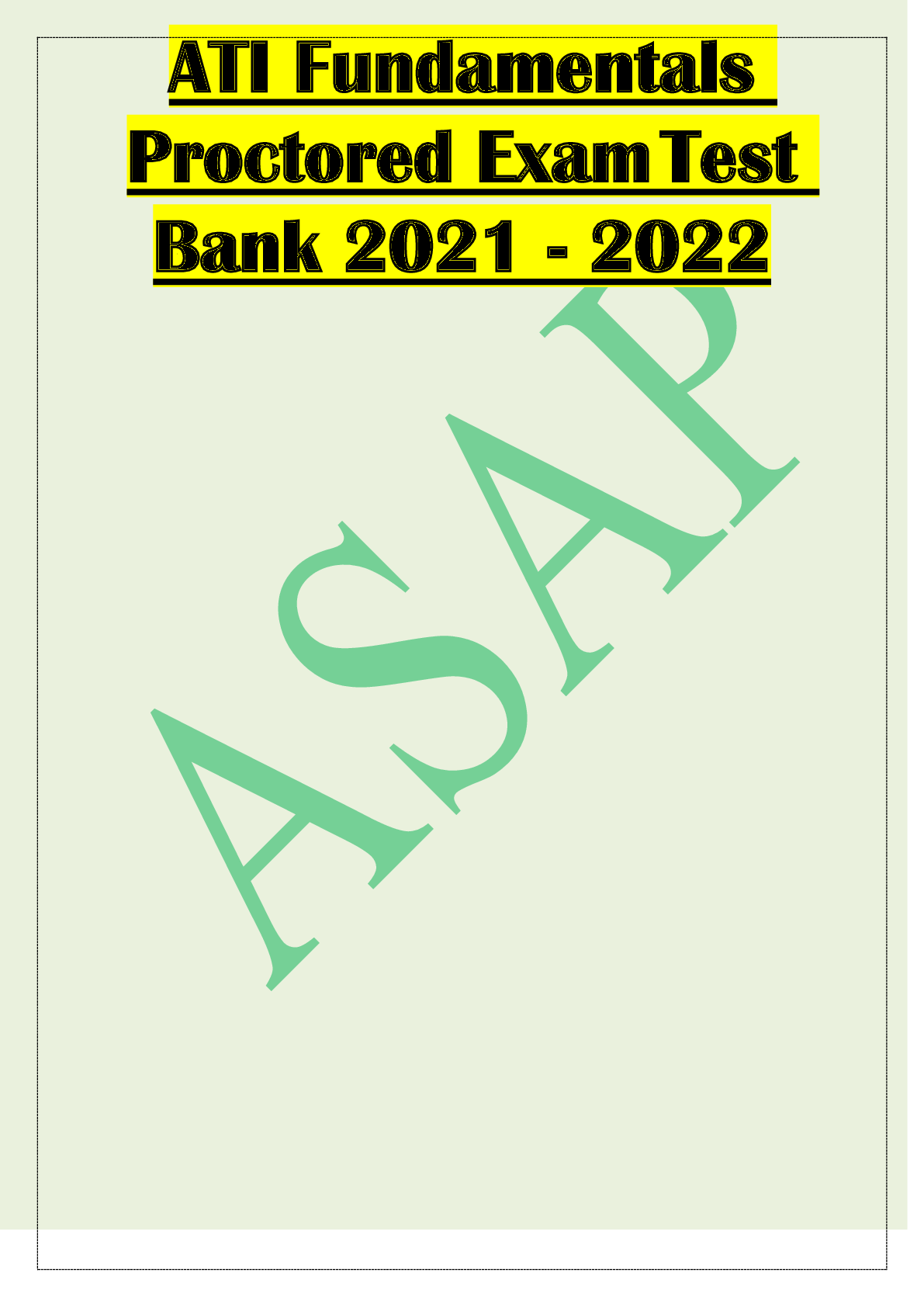
Reviews( 0 )
Document information
Connected school, study & course
About the document
Uploaded On
Sep 06, 2022
Number of pages
319
Written in
Additional information
This document has been written for:
Uploaded
Sep 06, 2022
Downloads
0
Views
104

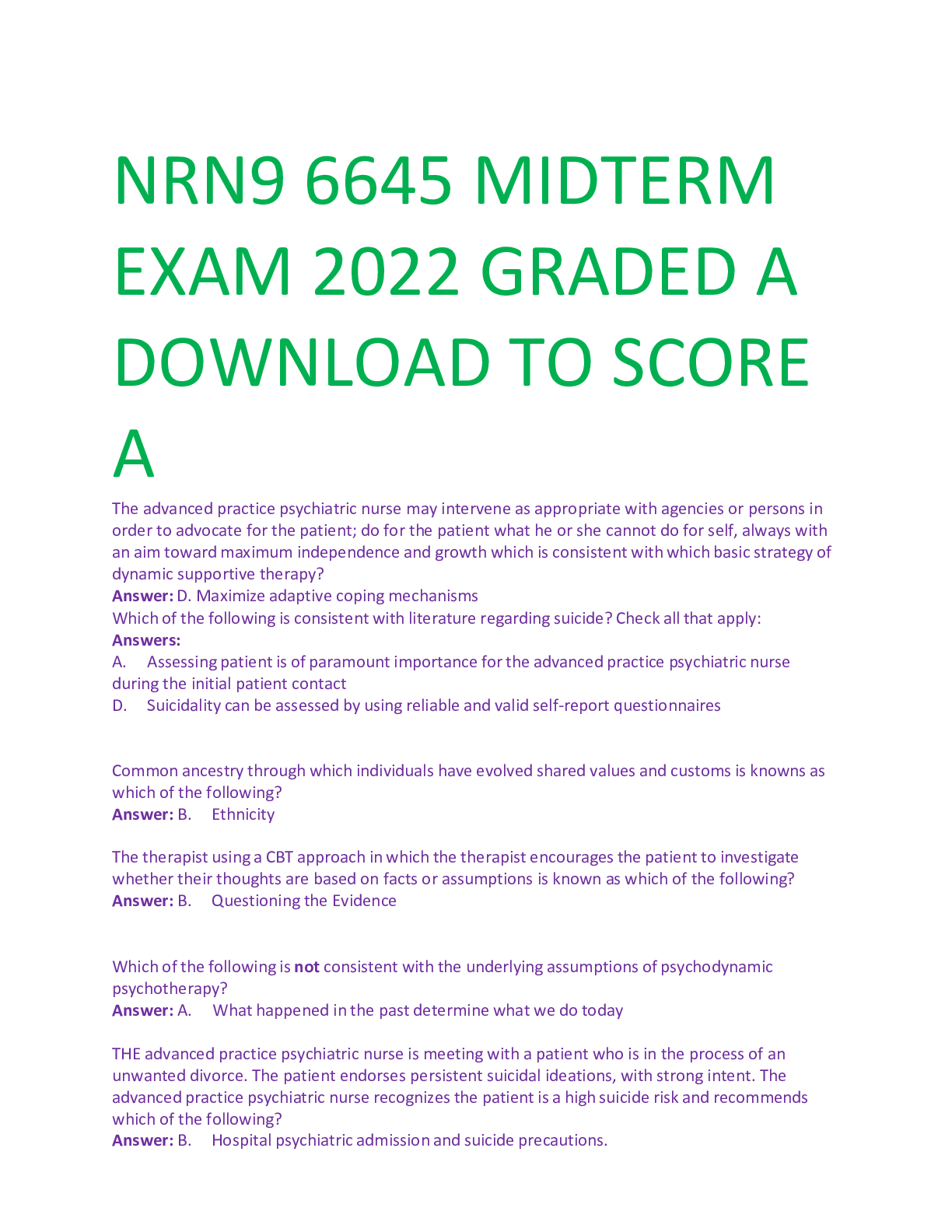
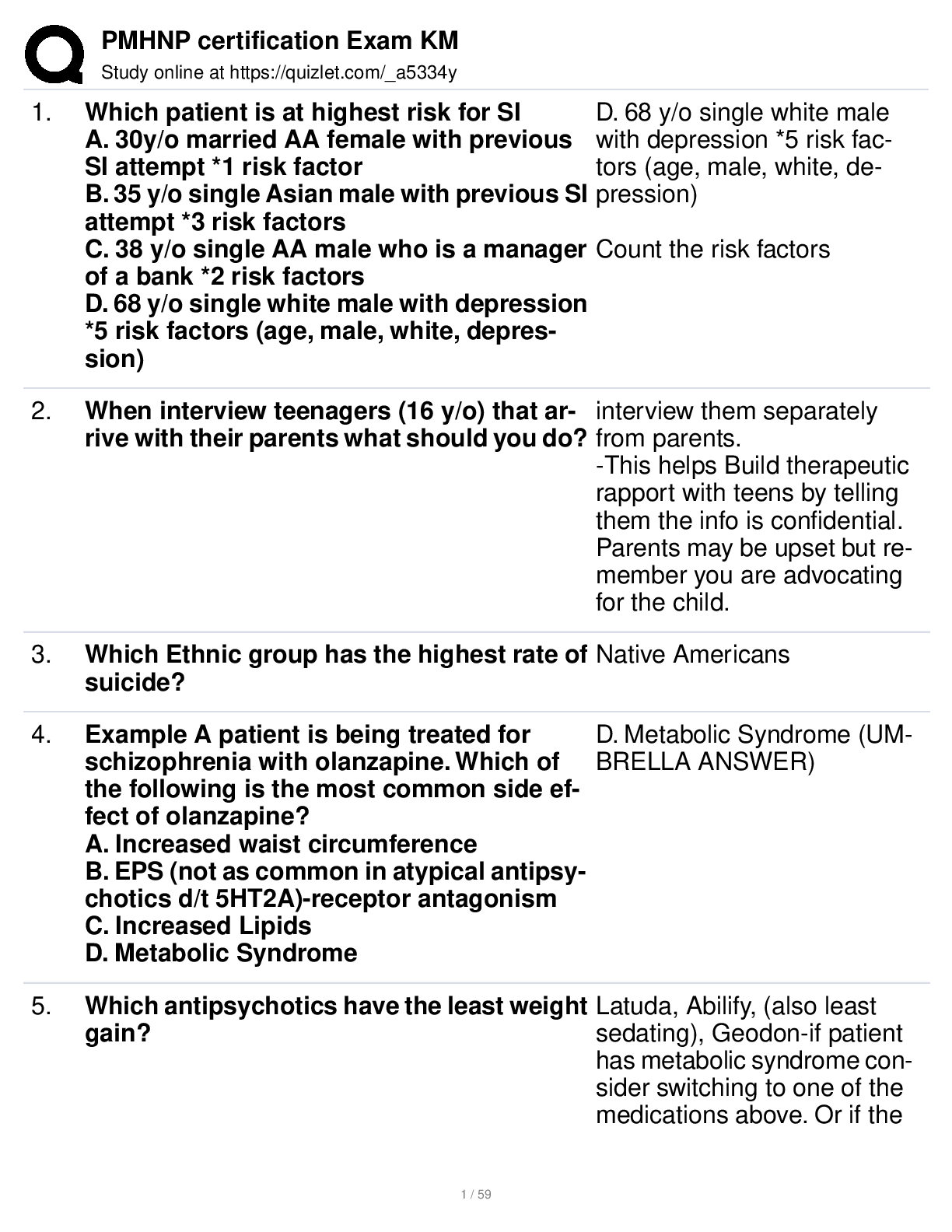
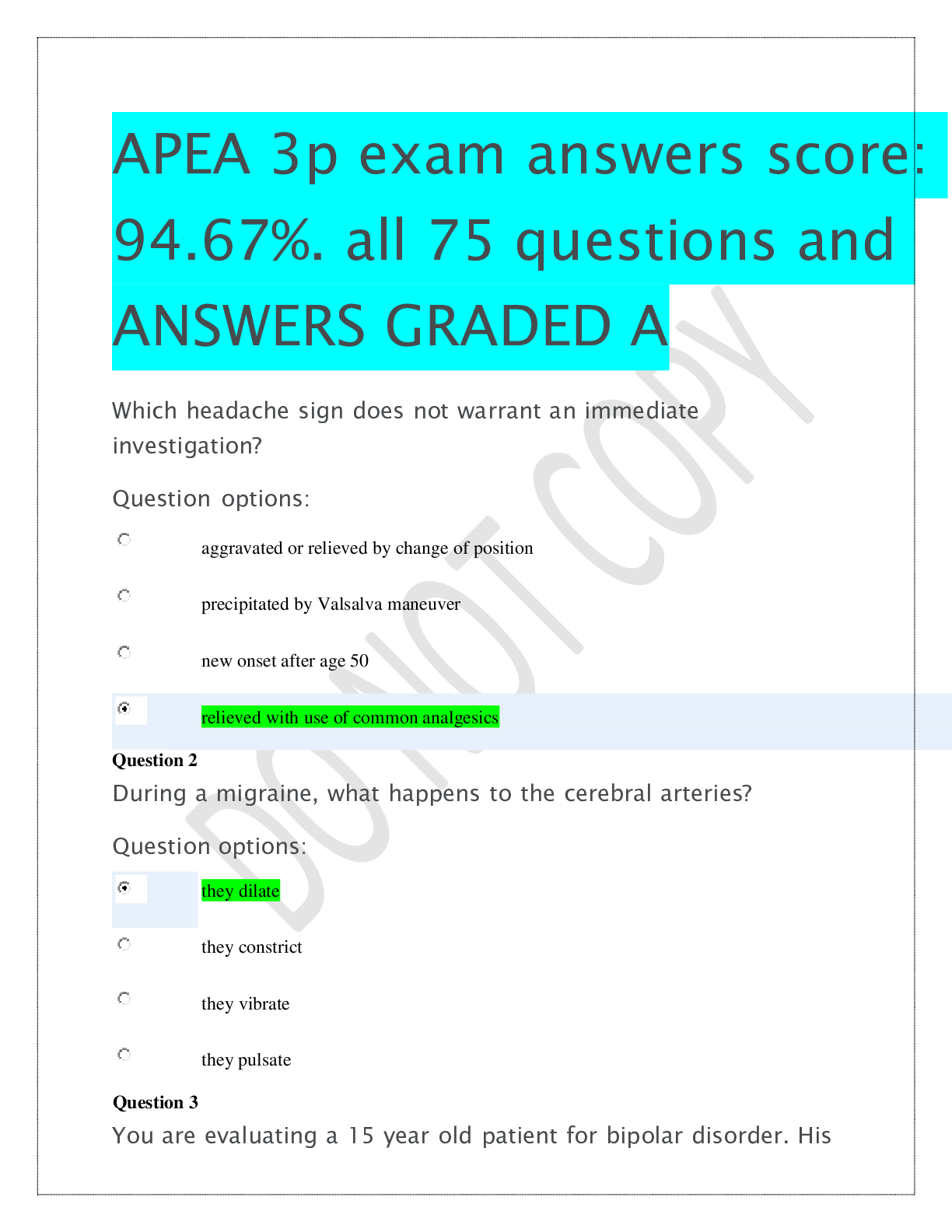
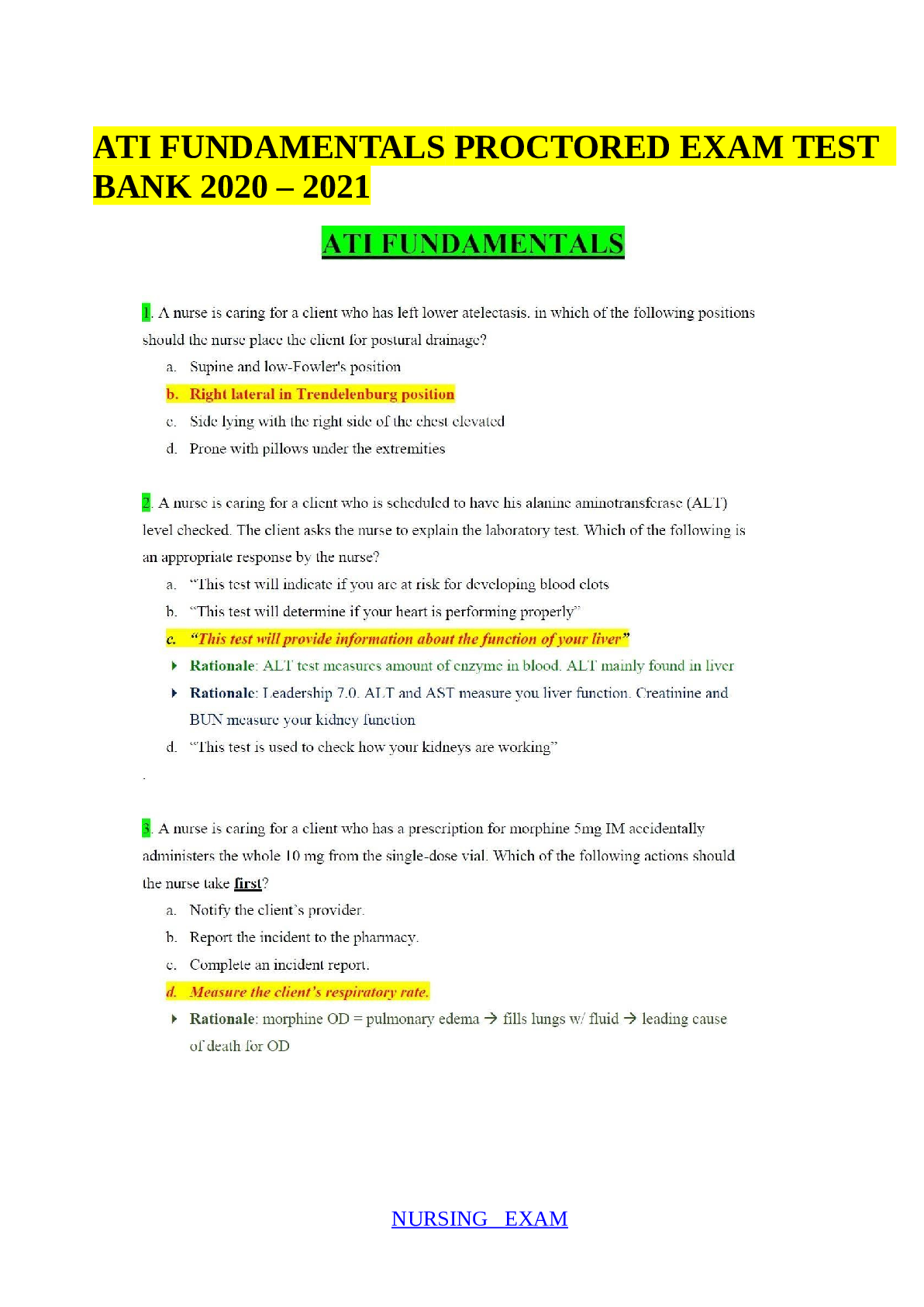
.png)
.png)


